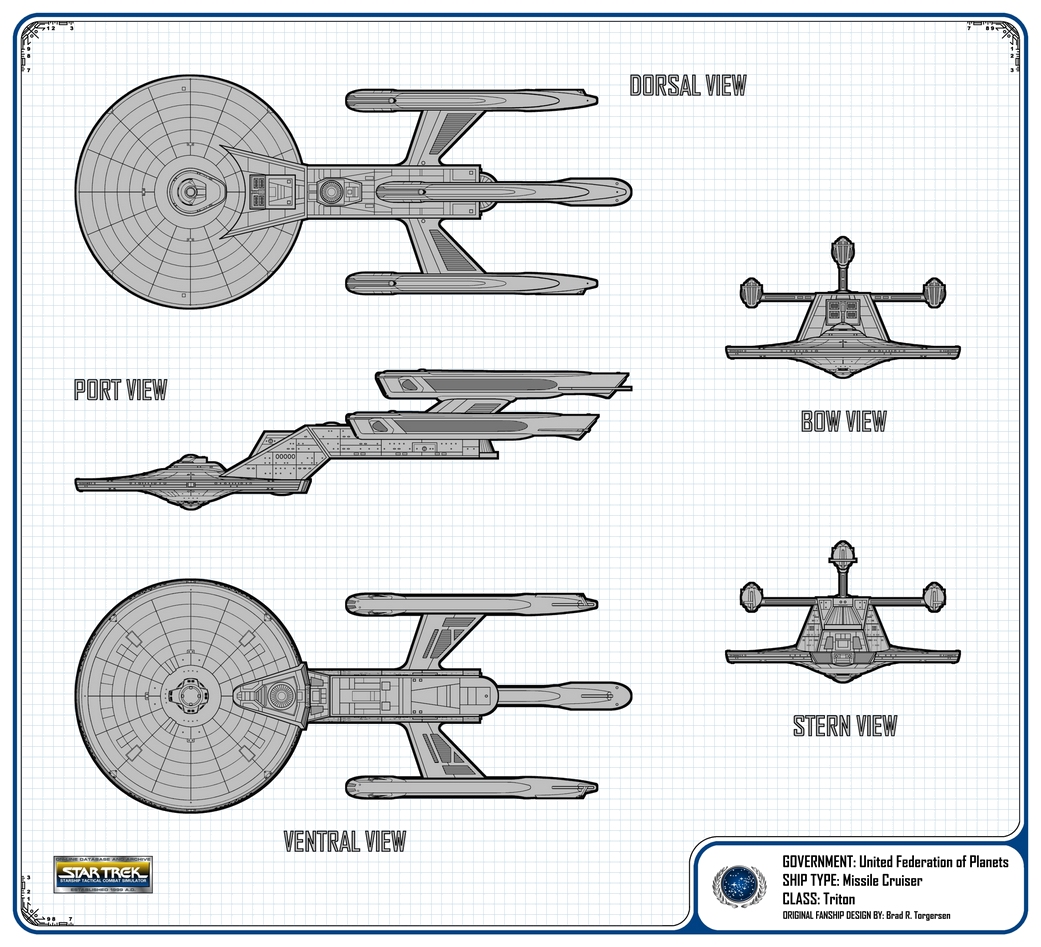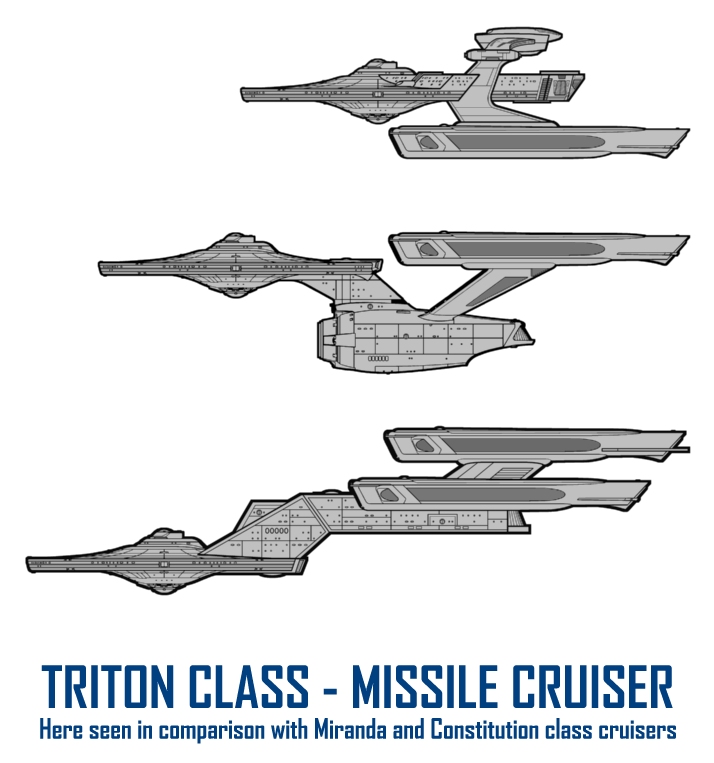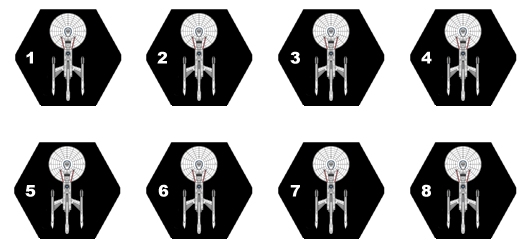![]()
Triton Class ● Missile Cruiser ● United Federation of Planets

CLICK ABOVE TO SEE A DOUBLE-SIZE BLUEPRINT
|
A SMALL NOTE REGARDING THE GENESIS OF THIS DESIGN. I first built this class as a smallish, crude cardboard model in the summer of 1989. The model itself has since been (mostly) destroyed by the forces of time and entropy, but I was always proud of it, and have since made two attempts to render the class in orthographic form via Paint Shop Pro. The first attempt was in 2002 and was about 85% true to the model, as I remember it. In 2007 I re-drew the blueprints, making some minor adjustments, including the proper scaling of the warp nacelles in the forward aspect, re-aligning the secondary hull when viewed from astern, and re-working the impulse deck design and its accompanying deflection crystal dome; including the addition of a secondary deflection crystal on the dorsal surface, as indicative of the auxiliary intermix column leading to the dorsal warp nacelle. — BRT
FANSHIP DESIGN & STATS: Brad R. Torgersen, 1989 - 2002 The aged detachment of Federation class battleships were pressed into service once again to patrol the former Klingon Neutral Zone and maintain the sovereignty of Federation space against Klingon rogues. A newer ship should have been used, but the Excelsior class heavy cruisers were still too few in number at that stage to be massed effectively. Besides which, the Excelsiors were needed far more on the frontier where their advanced sensors, speed, and laboratory facilities made them invaluable. Older cruiser designs such as the Miranda (Reliant) and Constitution (Enterprise) were proving to be somewhat outgunned by more recently-designed Klingon ships in the hands of renegade commanders, and there was an immediate need for a fast warship that could take over where the venerable Federation class ships left off. In order to minimize the time it would take to go from the drawing board to the construction yards, Starfleet contractors opted to implement a design that would use as many off-the-shelf components as possible, while still filling the requirements handed down from Starfleet Command. The result was the Triton class. The Mark I Triton began trials in late 2294 and was officially commissioned in 2295 when the USS Triton left Earth Spacedock for her first tour of duty along the boundary between Federation and Klingon space. Like the old Federation class, the Triton class bore a novel-looking set of three warp nacelles, all off-the-rack FWG type. Early tests during trials indicated that the warp geometry created by the three FWG nacelles was overly complex and yielded too little speed for too much power expended, so the engineers opted instead to use the third warp nacelle much like the third engine was once used on 20th century Earth DC-10 jetliners. The warp field itself would be maintained by just the two primary nacelles at any given moment, while the dorsal nacelle would act as a backup in case either one of the active two became damaged or destroyed in combat. The main offensive weapon of the Triton is its impressive forward-facing multi-tube torpedo bay. A specially designed superstructure juts from the sloping secondary hull to reveal apertures for four FP-5 model torpedo launchers. This bay assembly allows the Triton to concentrate a hail of heavy fire on its forward arc when attacking hostile starships. The effect is similar to that seen with the Andor class missile cruisers, which also mass torpedoes in the forward arc, delivering potentially crippling blows to even the largest enemy battleships. Finally, the Triton class is unusual for a cruiser in that a contingent of Starfleet Marines is aboard—for police actions and hostile ship boarding duty. In another time the Triton might have been classified a heavy frigate, but her sensors and long-range capability necessitated her classification as a cruiser, in spite of the onboard marines. It did not take long for the Triton class to bloody its blade. Five months after beginning patrol duty at the border, the USS Triton was set upon by a trio of hostile Klingon D-32 class cruisers under the command of a breakaway Klingon commander. The captain of the Triton reacted quickly and was able to pour all of the power from the dorsal nacelle into her shields, absorbing the initial Klingon barrage, while remaining warp power was channeled to phaser banks and, most importantly, the torpedoes. With one of the three D-32 cruisers swinging around for a second strike, the Triton locked all four of her FP-5 tubes onto the Klingon ship and fired. Surprised by the overwhelming concentration of torpedo fire issuing from the fore of the Triton, the D-32 had only a second or two for futile evasive maneuvers before two torpedoes struck and destroyed the left wing, tossing the cruiser backwards and exposing its belly to the remaining two torpedoes which penetrated shields and armor and reduced the Klingon aggressor to a cloud of flaming debris. Klingons being Klingons, the other D-32 cruisers regrouped and attacked again, battering through the Triton's semi-depleted shields and mangling the starboard warp nacelle before the Triton could return phaser fire and force the Klingons to break off their second strike. With the starboard nacelle hopelessly damaged, the backup power routines programmed into the M-6B computer flawlessly shunted warp field geometry to asymmetric mode, thus using the dorsal and port nacelles exclusively while the wreckage of the starboard nacelle was ejected from the end of its pylon. Running at two-thirds normal power, the ship swung about and the captain loaded up the torpedo assembly for another volley. As the Klingons dropped their wingtips to deliver some disruptor fire, the Triton cut loose with a second deadly hail of torpedoes, again smashing through the shields of a D-32 and severing the command pod from the rest of the craft. As the wreckage of the second D-32 pinwheeled away into the void, the Triton went nose to nose with her remaining enemy, which blasted the Triton with deadly green arcs of disruptor energy. Phaser fire was returned while the Triton's engineer fought to keep the shields from utterly collapsing, and several solid strikes sent the D-32 reeling. At this stage the Klingons decided that the day was not theirs for the taking, and began a retreat towards the border. Thanks to its asymmetric warp field programming and two operational nacelles, the Triton gave pursuit at medium to high warp for several tens of minutes, until a volley of torpedoes dropped the remaining D-32 from warp. Disabled, the Klingon D-32 drifted with shields down, and the captain of the Triton quickly marshaled her marines. Combat transporters hummed to life, and within half an hour the renegade Klingons had been captured along with their ship, to be delivered into the angry hands of official Imperial forces which arrived two days later. The renegades were all given life imprisonment at Rura Kathol penal colony, while the Triton was actually able to resume patrol duties for two weeks until the USS T'Nir, a Miranda (Reliant) class cruiser, was able to relieve the damaged Triton and allow her to reach a Starbase for repair. When the after-action reports of the incident reached San Francisco, Starfleet Command was very pleased with the performance of their three-engined "off the shelf" ship, and a production run of over 80 vessels was ordered through 2305 A.D. At least eight Mark I ships were built every year until 2306, at which point the Mark II model became the focus of production. The Mark II model was identical to the Mark I in appearance, but a much more powerful impulse deck was mounted to give the class extra maneuvering ability at sub-warp, while yielding still more energy for shields and phasers. More superstructure was added to handle the new deck, and an extra bank of phasers was mounted in the aft arc in order to make up for the fact that the design did not mount torpedoes capable of firing to stern. Of the 62 Mark I ships that remained in active service by 2309, all were eventually upgraded to Mark II refit specs by 2315 A.D. By 2327 the Triton class was starting to show its age. With next generation vessels like the Excelsior Refit class, Constellation class, and other ships taking over patrol duties, and with the danger along the Klingon border largely reduced, the Triton was given a final upgrade before being reassigned to a variety of alternative duties in other areas. Never intended as an exploration vessel, several Mark III Triton class ships did prove noteworthy in their exploration of the Beta Quadrant. And even though hostile ship-to-ship boarding action was almost never seen by the Mark III, the contingent of marines left aboard still proved quite valuable, as either peacekeepers, or as a tactical assault force on frontier worlds across the Federation rim. By 2345 the Triton class began to near the end of its effective lifespan. 109 of the original combined production run of 181 vessels had survived and were still in service as Mark III's, either with Starfleet Reserve, or as training ships with the Starfleet Academy, or occasionally as mainline units still on active duty. According to Starfleet protocol, in 2346 the Triton ships began to be slowly culled from the fleet and occasionally mothballed or, as was more often the case, scrapped. The last mainline operational Triton was decommissioned in 2360, some 65 years after the original conception of the class. By 2365 only five Triton class ships remained in existence, three of which were in museums across the Federation and two of which were in mothballs, one stored at the Oort Twelve facility in Sol System. This particular Triton, the USS Hillside, saw action one last time in 2367 after being revived on emergency call-up to fight off the Borg invasion of Federation space. Crewed by a hastily assembled mix of Academy cadets and Starfleet reservists, the USS Hillside was part of the 39 ship fleet that took on a Borg cube at Wolf 359. Little data survived the battle to indicate how the aged Hillside faired against the Borg. Nevertheless, the valiant death of the Hillside serves as an appropriate capper to the noteworthy career of the Triton design. |

| Construction Data: Model Numbers- Ship Class- Date Entering Service- Number Constructed |
MK I XIII 2295 A.D. 85 |
MK II XIII 2309 A.D. 96 |
MK III XIII 2327 A.D. (refit only) |
| Hull Data: Superstructure Points- Damage Chart- Size Length- Width- Height- Weight- Cargo Cargo Units- Cargo Capacity- Landing Capability- |
29 C 336.9 meters 141 meters 84.6 meters 212,300 tons 600 units 30,000 tons None |
33 C 336.9 meters 141 meters 84.6 meters 218,100 tons 600 units 30,000 tons None |
36 C 336.9 meters 141 meters 84.6 meters 222,600 tons 600 units 30,000 tons None |
| Equipment Data: Control Computer Type- Transporters- Standard 6-person- Combat 20-person- Emergency 22-person- cargo large- cargo small- |
M-6B 5 4 4 3 2 |
M-6B 5 4 4 3 2 |
M-6C 5 4 4 3 2 |
| Other Data: Crew- Marines- Passengers- Shuttlecraft- |
400 120 40 12 |
390 120 40 12 |
375 120 40 12 |
| Engines and Power Data: Total Power Units Available- Movement Point Ratio- Warp Core Type- Warp Core Output- Stress Charts- Maximum Safe Cruising Speed- Emergency Speed- Impulse Reactor(s) Type- Impulse Reactor(s) Output-- |
86 5/1 FWG-3 78 D/F Warp 8 Warp 9.9 FIE-2 8 |
94 5/1 FWG-3 78 D/F Warp 8 Warp 9.9 FIE-3 16 |
100 5/1 FWG-4 84 D/F Warp 8 Warp 9.9 FIE-3 16 |
| Weapons and Firing Data: Beam Weapon Type- Number- Firing Arcs- Firing Chart- Maximum Power- Damage Modifiers +3 +2 +1 Missile Weapon Type- Number- Firing Arcs- Firing Chart- Power To Arm- Damage- |
FH-11 8 in four banks 2f/p, 2f, 2f/s, 2a Y 10 (1 - 10) (11 - 17) (18 - 24) FP-5 4 F R 1 16 |
FH-11 10 in five banks 2f/p, 2f, 2f/s, 2a/s, 2a/p Y 10 (1 - 10) (11 - 17) (18 - 24) FP-5 4 F R 1 16 |
FH-11 10 in five banks 2f/p, 2f, 2f/s, 2a/s, 2a/p Y 10 (1 - 10) (11 - 17) (18 - 24) FP-4 4 F S 1 20 |
| Shields Data: Deflector Shield Type- Shield Point Ratio- Maximum Shield Power- |
FSP 1/4 16 |
FSP 1/4 16 |
FSN-X3 1/3 18 |
| *Defense Factor- *Weapon Damage Factor- |
159.47 123.6 |
175.19 123.6 |
162.48 135.6 |
* Special thanks to Bryan for figuring out the D and WDF for this fanship!

CLICK HEX GAME PIECES TO VIEW AND PRINT SEPARATELY